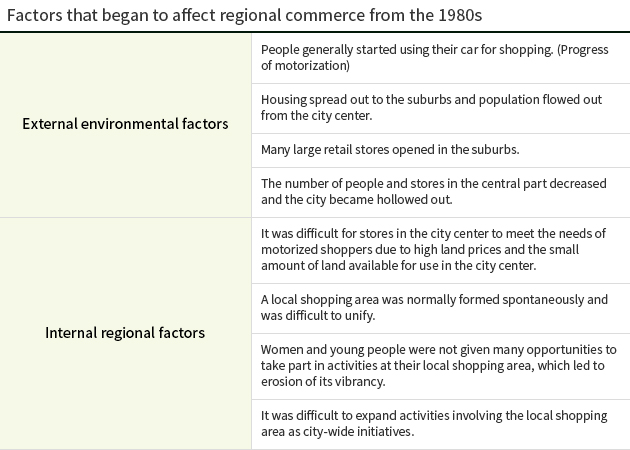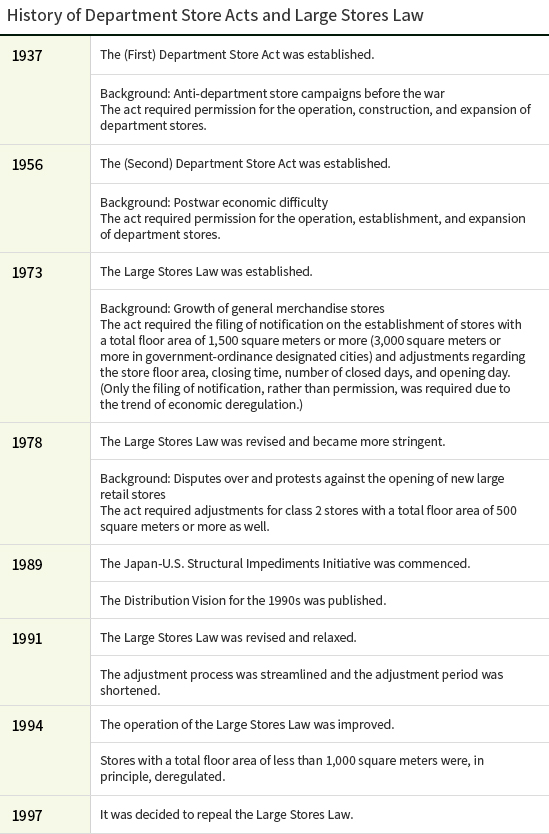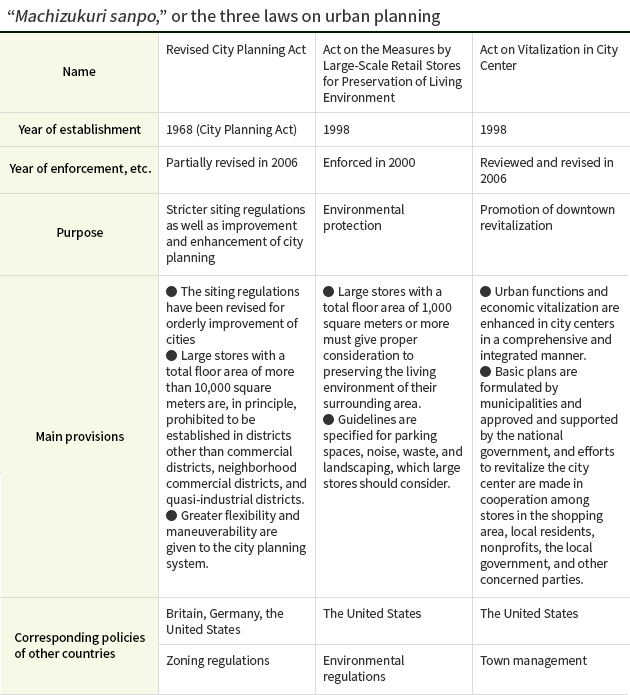Is your local shopping area lively? When you were a child, you probably used to greet adults in the shopping strip and perhaps may sometimes have been scolded by them. The street was full of people and energy. But the strip has quickly become deserted and is now lined with out-of-business shops with closed shutters. This kind of shopping strip can probably be found anywhere in Japan. For many of you, huge shopping malls, rather than your local shopping area, may have been your usual shopping place since you were born.
This kind of decline in regional commerce started to become evident in around 1980. The five largest retail companies at that time (Daiei, Ito-Yokado, Seiyu, JUSCO, Nichii) raced to open new stores, made inroads into regional markets, and began to eat into the profits of local supermarkets and shopping areas. This harsh competition was called a “warring period” for distributors. The advance of large retailers caused various problems for regional commerce, but the biggest factor that made the condition serious was the progress of motorization.
In Japan, small and medium-sized retailers had been considered the backbone of society and the promotion of small and medium-sized retail commerce and the modernization of distribution had been two basic policies that were implemented steadfastly. As the table shows, however, the progress of motorization brought about various changes in society, such as a change in shopping behavior, the shift in population to the suburbs, and the opening of large retailers in the suburbs, causing the gradual decline of local shopping areas. It is, however, during the 20 years since the 1990s to now that the situation changed drastically for local shopping areas. As a major factor behind this change, the effect of the Act on the Adjustment of Business Activities of Retail Business at Large-scale Retail Stores (repealed in June 2000; hereinafter the “Large Stores Law”) was significant and cannot be ignored.
The Large Stores Law was a law aimed at alleviating the friction between large retail stores and small and medium-sized retail stores and reconciling their confrontation. The law required adjustments regarding the store floor area, closing time, number of closed days, and opening day of new large retail stores above a certain size. Under this law, it was ensured that the opinion of the local community would be reflected in the opening of a large retail store. While this caused lengthy and often opaque adjustment processes and some other problems, there was a need to control the impact of the opening of new large retail stores on regional commerce.

An extension of its predecessors, the prewar First Department Store Act and the postwar Second Department Store Act, the Large Stores Law stipulated the way in which regional commerce should be protected as part of the government’s commercial adjustment policy. It was a system unique to Japan and, as a matter of fact, was criticized as a law exemplifying the peculiarity of Japanese distribution.
The law was particularly criticized when Japan was urged by the United States to open its market to reduce the trade imbalance between Japan and the United States in the mid-1980s because the law constituted an obstacle for foreign large retailers who intended to advance into the Japanese market. This resulted in the inclusion of the relaxation of the law in the agenda of the Japan-U.S. Structural Impediments Initiative (SII) talks, which started in 1989. The law was also criticized in Japan as well because it was seen as impeding free corporate activities, inhibiting the innovative development of the Japanese distribution industry, and delaying the structural reform.
On the other hand, there was also an opinion that said that the law should be recognized as having a certain significance of its own. It is true that the law was playing the role of protector of small and medium-sized retailers. But another intention of the law was to help advance the structural reform smoothly by minimizing the negative effects of the rapid changes that could take place in the process of the modernization of distribution. This is the reason why the Small and Medium-sized Retail Business Promotion Act came into effect at the same time as the Large Stores Law was established in 1973, with the aim of strengthening the operating foundations and promoting the sound development of small and medium-sized retailers.
Furthermore, an idea emerged in the mid-1980s that rather than competing, large retailers and small and medium-sized retailers should coexist and cooperate with each other in order to elevate the appeal of the city as a whole. People were also beginning to understand that the opening of large retail stores in the suburbs was taking business away from large retailers in the city center, prompting them to withdraw from their central locations, which, in turn, accelerated the decline of the city. Thus the limitations of the Large Stores Law were beginning to be recognized and the need was emerging to re-examine the way regional commerce should operate.
The Large Stores Law, for which opinions in Japan were divided as to the pros and cons, was revised in 1991, partly as a result of the SII, and was improved in its operation in 1994. Through this revision and improvement, large retailers were given much greater liberty to open their stores, triggering a heated race among them to expand their business and speeding up the erosion of regional commerce. The globalization trends required even domestic systems to be more transparent. The unregulated opening of stores in the suburbs caused traffic congestion and adversely affected the environment, posing a great concern. While people sought the convenience of going shopping by car, the number of shuttered stores increased in local shopping areas, causing an increasing number of consumers living in the city center to feel that shopping in their own neighborhood was inconvenient. The Large Stores Law was unable to solve this kind of problem faced by people who only had limited access to shopping facilities.
To address this situation, the Japanese government assembled and sent experts to the United States, Germany, Britain, France, and other Western countries in early 1990 to conduct intensive research and study their policies on large stores. From these efforts, the government discovered the need for a comprehensive regional commerce policy centering on considerations to local communities and environmental problems. The times changed and the role of the Large Stores Law came to an end.

The Large Stores Law has been replaced by the so-called “machizukuri sanpo” or the three laws on urban planning, which were formulated based on the study conducted on policies of Western countries. They are the Act on the Measures by Large-Scale Retail Stores for Preservation of Living Environment, which is aimed at environmental protection; the Act on Vitalization in City Center, which supports local revitalization; and the revised City Planning Act, which governs siting.

Although it is only just under 10 years since the three laws were established to help revitalize hollowed-out cities, what needs to be done to succeed in the revitalization is becoming clear.
Firstly, we need to create a place in the city center to meet and interact with other people. In the old days, local shopping areas were a place not just for shopping but also to meet and interact with other people. So the first step toward revitalization is to organize various events in the city center, such as farmers’ markets, festivals, concerts, and plays, to make it a place for fun.
Secondly, we need to restore urban functions in the city center to support the day-to-day lives of residents. These functions include city hall, hospitals/clinics, post offices, kindergartens, day care centers, and libraries. These facilities may appear irrelevant to retail activities, but when all these urban and retail functions become one to constitute the city center, it will make the city center attractive.
Thirdly, we need to promote city centers as residential areas. In Japanese cities, high land prices at the center are making housing development difficult. To address this problem, a policy needs to be developed and implemented to provide low-cost yet high-quality housing to make it easier for young couples and others on an average income to live in the city center. The more residents, the more shoppers there will naturally be, leading to the revitalization of the local shopping area. There is also a need to pursue and come up with innovative policies, such as leasing vacant stores in the local shopping area to young people who may have only a small amount of funds but are willing to run a business or renting out unoccupied houses to young couples. Thus policy-led measures are required to maintain urban living infrastructure.
Cities that are back on track to revitalization have one thing in common: the entire city is united as one team. Their activities are diverse, including planning events, developing local brands, and offering sweets and other fare made from local ingredients. Furthermore, experts in product planning, design, marketing, and other fields are joining these activities, making it possible to realize even more attractive product development, package design, advertising, event planning, and effective utilization of vacant stores. Young people who find such local activities interesting are returning to their hometowns, and famous designers are beginning to base their activities in local areas. All these trends are helping expand the network of people in the regions. The next challenge is to connect these trends to the generation of jobs in regional businesses and the independence of each region.
It is still only some cities that are showing positive signs in their revitalization, but there are good prospects for cities to regain their vigor.
When many large retailers opened one store after another in the suburbs in the 1980s, many consumers were attracted to such large stores. Large stores had their own appeal and convenience, as they were able to keep their products at low prices through volume purchasing and offer one-stop shopping for food, clothes, shoes, and various other items. They were also handy for shoppers with cars.
However, the awareness and values of consumers have changed. The number of consumers who attach importance to taste and quality and prefer to eat safer and more delicious foods has been increasing since the mid-1990s. Traditional foods are being re-evaluated, and campaigns for teaching children the importance of food are spreading. To meet these changing trends, small and medium-sized retailers can capitalize on their individuality and distinctiveness. They can develop with local farmers products with limited availability or full of originality using locally sourced ingredients and sell them. They can also build a strong relationship with customers through everyday conversation, learn about their customers’ preferences, and take advantage of this knowledge to optimize their offerings. If small and medium-sized retailers are able to secure two very basic elements of their business—good customers and product sources—they will have a good chance for recovery.
The shift in regional commerce policy from the Large Stores Law to the three laws on urban planning also represents the process of Japan transforming into a mature civil society. In this sense, the two lost decades can also be interpreted as a very important transitional period in which Japanese society moved slowly to a new stage.
In this column, I focused on “distribution” by tracing the change in regional commerce policy. Japan’s distribution has been going through a turbulent time for about 30 years since the 1980s. The rapid changes seen during these decades cannot be described simply in terms of the relationship between large retailers and small and medium-sized retailers; they are much more complex, involving the decline of regional communities, change of values, globalization, and the shift in Japan’s industrial structure. I hope that you understand this complexity.
Distribution directly reflects the change in consumer values. Distribution changes along with the change in people’s lifestyles. I will be pleased if, through this column, you have found something of interest in distribution.
(This column is as of 2012.)